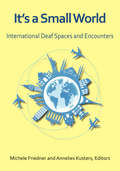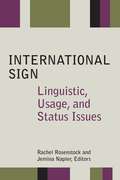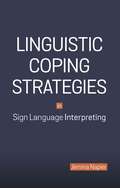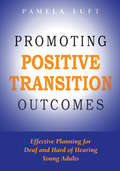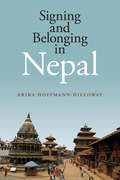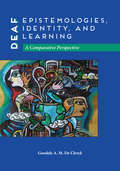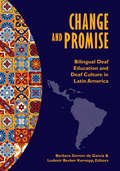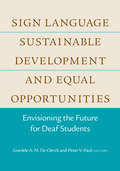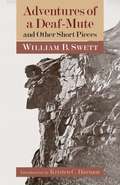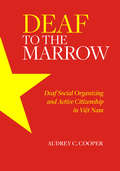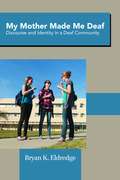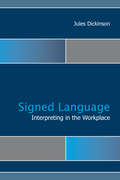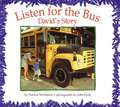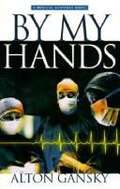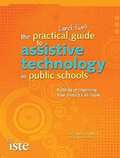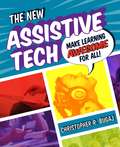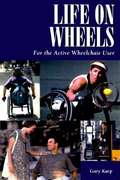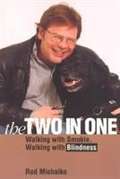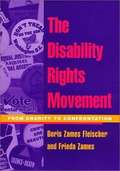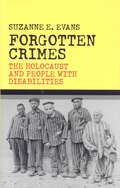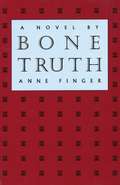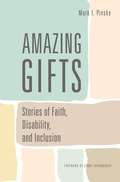- Table View
- List View
It’s a Small World: International Deaf Spaces and Encounters
by Michele Friedner Annelies KustersIt's a Small World explores the fascinating and, at times, controversial concept of DEAF-SAME ("I am deaf, you are deaf, and so we are the same") and its influence on deaf spaces locally and globally. The editors and contributors focus on national and international encounters (e.g., conferences, sporting events, arts festivals, camps) and the role of political/economic power structures on deaf lives and the creation of deaf worlds. They also consider important questions about how deaf people negotiate DEAF-SAME and deaf difference, with particular attention to relations between deaf people in the global South (countries in Africa, Asia, and Latin America, with access to fewer resources than other countries) and the global North (countries in Europe, along with Canada, the US, Australia, and several other nations with access to and often control of resources). Editors Michele Friedner and Annelies Kusters and their contributors represent a variety of academic and professional fields, from anthropology and linguistics to cultural and religious studies. Each chapter in this original volume highlights a new perspective on the multiple intersections that occur between nationalities, cultures, languages, religions, races, genders, and identities. The text is organized into five sections--Gatherings, Language, Projects, Networks, and Visions. Taken all together, the 23 chapters in this book provide an understanding of how sameness and difference are powerful yet contested categories in deaf worlds.
International Sign: Linguistic, Usage, and Status Issues
by Jemina Napier Rachel RosenstockInternational Sign (IS) is widely used among deaf people and interpreters at international events, but what exactly is it, what are its linguistic features, where does its lexicon come from, and how is it used at interpreted events? This groundbreaking collection is the first volume to provide answers to these questions. Editors Rachel Rosenstock and Jemina Napier have assembled an international group of renowned linguists and interpreters to examine various aspects of International Sign. Their contributions are divided into three parts: International Sign as a Linguistic System; International Sign in Action—Interpreting, Translation, and Teaching; and International Sign Policy and Language Planning. The chapters cover a range of topics, including the morphosyntactic and discursive structures of interpreted IS, the interplay between conventional linguistic elements and nonconventional gestural elements in IS discourse, how deaf signers who use different signed languages establish communication, Deaf/hearing IS interpreting teams and how they sign depicting verbs, how best to teach foundation-level IS skills, strategies used by IS interpreters when interpreting from IS into English, and explorations of the best ways to prepare interpreters for international events. The work of the editors and contributors in this volume makes International Sign the most comprehensive, research-based analysis of a young but growing field in linguistics and interpretation.
Linguistic Coping Strategies in Sign Language Interpreting
by Jemina NapierThis ground-breaking work, originally published 15 years ago, continues to serve as the primary reference on the theories of omission potential and translational contact in sign language interpreting. In the book, noted scholar Jemina Napier explores the linguistic coping strategies of interpreters by drawing on her own study of the interpretation of a university lecture from English into Australian Sign Language (Auslan). A new preface by the author provides perspective on the importance of the work and how it fits within the scholarship of interpretation studies. The concept of strategic omissions is explored here as a tool that is consciously used by interpreters as a coping strategy. Instead of being a mistake, omitting part of the source language can actually be part of an active decision-making process that allows the interpreter to convey the correct meaning when faced with challenges. For the first time, Napier found that omission potential existed within every interpretation and, furthermore, she proposed a new taxonomy of five different conscious and unconscious omission types. Her findings also indicate that Auslan/English interpreters use both a free and literal interpretation approach, but that those who use a free approach occasionally switch to a literal approach as a linguistic coping strategy to provide access to English terminology. Both coping strategies help negotiate the demands of interpretation, whether it be lack of subject-matter expertise, dealing with dense material, or the context of the situation. Napier also analyzes the interpreters' reflections on their decision-making processes as well as the university students' perceptions and preferences of their interpreters' linguistic choices and styles. Linguistic Coping Strategies in Sign Language Interpreting is a foundational text in interpretation studies that can be applied to interpreting in different contexts and to interpreter training.
Promoting Positive Transition Outcomes: Effective Planning for Deaf and Hard of Hearing Young Adults
by Pamela LuftMany students struggle with the transition from high school to the next stage of their lives. For deaf and hard of hearing (DHH) students, that struggle can be intensified by barriers and discriminatory attitudes they face in their communities, schools, and workplaces. Though much progress has been made, they are often underemployed and underpaid, and they receive postsecondary training at lower rates than other disability groups. Author Pamela Luft explores the reasons for these statistics and offers strategies and resources that can improve outcomes. Promoting Positive Transition Outcomes is the most comprehensive discussion of transition planning and results for DHH students now available. Luft begins with an overview of the historical and current challenges to DHH students and their academic and vocational potential. She explores the importance of forming an identity and building foundational social and problem-solving skills. She then reviews the history of rehabilitation and workforce legislation, which now mandates that every student with an individualized education plan (IEP) have a transition plan in place by the age of 16. Most schools, however, are not equipped to meet the needs of a population as diverse as DHH students. She examines the services that are currently available in high schools and offers recommendations for strengthening transition team planning by reaching out to external experts. The volume concludes with suggestions for creating a framework to address the challenges of transition planning for deaf and hard of hearing students and offers guidance on building effective plans.
Signing and Belonging in Nepal
by Erika Hoffmann-DillowayWhile many deaf organizations around the world have adopted an ethno-linguistic framing of deafness, the meanings and consequences of this perspective vary across cultural contexts, and relatively little scholarship exists that explores this framework from an anthropological perspective. In this book, Erika Hoffmann-Dilloway presents an accessible examination of deafness in Nepal. As a linguistic anthropologist, she describes the emergence of Nepali Sign Language and deaf sociality in the social and historical context of Nepal during the last decades before the Hindu Kingdom became a secular republic. She then shows how the adoption of an ethno-linguistic model interacted with the ritual pollution model, or the prior notion that deafness results from bad karma. Her focus is on the impact of these competing and co-existing understandings of deafness on three groups: signers who adopted deafness as an ethnic identity, homesigners whose ability to adopt that identity is hindered by their difficulties in acquiring Nepali Sign Language, and hearing Nepalis who interact with Deaf signers. Comparing these contexts demonstrates that both the ethno-linguistic model and the ritual pollution model, its seeming foil, draw on the same basic premise: that both persons and larger social formations are mutually constituted through interaction. Signing and Belonging in Nepal is an ethnography that studies a rich and unique Deaf culture while also contributing to larger discussions about social reproduction and social change.
Deaf Epistemologies, Identity, and Learning: A Comparative Perspective
by Goedele A. De ClerckGoedele A. M. De Clerck presents cross-cultural comparative research that examines and documents where deaf flourishing occurs and how it can be advanced. She spotlights collective and dynamic resources of knowledge and learning; the coexistence of lived differences; social, linguistic, cultural, and psychological capital; and human potential and creativity. Deaf Epistemologies, Identity, and Learning argues for an inclusive approach to the intrinsic human diversity in society, education, and scholarship, and shows how emotions of hope, frustration, and humiliation contribute to the construction of identity and community. De Clerck also considers global to local dynamics in deaf identity, deaf culture, deaf education, and deaf empowerment. She presents empirical research through case studies of the emancipation processes for deaf people in Flanders (a region of Belgium), the United States (specifically, at Gallaudet University in Washington, DC), and the West African nation of Cameroon. These three settings illuminate different phases of emancipation in different contexts, and the research findings are integrated into a broader literature review and subjected to theoretical reflection. De Clerck’s anthropology of deaf flourishing draws from her critical application of the empowerment paradigm in settings of daily life, research, leadership, and community work, as she explores identity and well-being through an interdisciplinary lens. This work is centered around practices of signed storytelling and posits learning as the primary access and pathway to culture, identity, values, and change. Change driven by the learning process is considered an awakening—and through this awakening, the deaf community can gain hope, empowerment, and full citizenship. In this way, deaf people are allowed to shape their histories, and the result is the elevation of all aspects of deaf lives around the world.
Change and Promise: Bilingual Deaf Education and Deaf Culture in Latin America
by Barbara Gerner Gerner de Garcia Lodenir Becker KarnoppWithin the past few decades, there has been great progress in deaf education in Latin America and growth in the empowerment of their Deaf communities. However, there is little awareness outside that region of these successes. For the first time, this book provides access, in English, to scholarly research in these areas. Written by Latin American Deaf and hearing contributors, Change and Promise provides a counter argument to external, deficit views of the Latin American Deaf community by sharing research and accounts of success in establishing and expanding bilingual deaf education, Deaf activism, Deaf culture, and wider access for deaf children and adults. Change and Promise describes the historical, cultural, and political contexts for providing bilingual deaf education in Latin America. Bilingual deaf education uses students’ sign language, while simultaneously giving them access to and teaching them the majority spoken/written language. This book describes current bilingual deaf education programs in the region that have increased society’s understandings of Deaf culture and sign languages. This cause, as well as others, have been championed by successful social movements including the push for official recognition of Libras, the sign language of Brazil. Change and Promise covers this expanding empowerment of Deaf communities as they fight for bilingual deaf education, sign language rights, and deaf civil rights. Despite the vast political and cultural differences throughout Latin America, an epistemological shift has occurred regarding how Deaf people are treated and their stories narrated, from labeling “deaf as handicapped” to being recognized as a linguistic minority. This panoramic study of these challenges and triumphs will provide an invaluable resource for improving outcomes in deaf education and help to secure the rights of deaf children and adults in all societies.
Sign Language, Sustainable Development, and Equal Opportunities: Envisioning the Future for Deaf Students
by Goedele A. De Clerck Peter V. PaulIncreased interaction between sign language communities and the mainstream societies in which they function is creating the potential for greater equality of opportunity for people who are deaf and hard of hearing. In this volume, renowned scholars and policy makers from around the world present innovative and groundbreaking perspectives on the relationships among sign language, sustainable development, and equal opportunities. The contributors to this volume offer creative and open-minded explorations of the construct of sustainability that are informed by their work with deaf individuals, deaf communities, families of deaf children, and other stakeholders. Sign Language, Sustainable Development, and Equal Opportunities describes sustainability in relation to: · identity, resilience, and well-being · participatory citizenship · historical perspectives on sign language use in educational contexts · sign language learning and teaching · human rights and inclusive education · literate thought and literacy · the sign language factor and the development of sign language communities in sub-Saharan Africa · sign language legislation These changing communities’ understanding of what is required to become sustainable—in areas such as full participation and citizenship in society, economic well-being, access to quality education, and cultural and linguistic identity—is also taking new forms. This work contributes to the paradigm shifts regarding deaf emancipation and deaf education taking place around the world.
Adventures of a Deaf-Mute and Other Short Pieces
by Kristen C. Harmon William B. SwettIn Adventures of a Deaf-Mute, Deaf New Englander William B. Swett recounts his adventures in the White Mountains of New Hampshire in the late 1860s. Given to us in short, energetic episodes, Swett tells daring stories of narrow escapes from death and other perilous experiences during his time as a handyman and guide at the Profile House, a hotel named for the nearby Old Man of the Mountain rock formation. A popular destination, the hotel attracted myriad guests, and Swett’s tales of rugged endurance are accompanied by keen observations of the people he meets. Confident in his identity as a Deaf “mute,” he notes with wry humor the varied perceptions of deafness that he encounters. As a signing Deaf person from a prominent multigenerational Deaf family, he counters negative stereotypes with generosity and a smart wit. He takes pride in his physical abilities, which he showcases through various stunts and arduous treks in the wilderness. However, Swett’s writing also reveals a deep awareness of the fragility and precariousness of life. This is a portrait of a man testing his physical and emotional limits, written from the vantage point of someone who is no longer a young man but is still very much in the prime of his life. This collection also includes “Mr. Swett and His Diorama,” an article from 1859 in which Swett describes his miniature recreation of the Battle of Lexington, as well as Manual Alphabets, a pamphlet published in 1875 on the history of manual alphabets that includes short biographies of Thomas Hopkins Gallaudet and Laurent Clerc, two pioneers of Deaf education in the United States. The work is accompanied by a new introduction that offers a reflection on Swett’s life and the time in which he lived.
Deaf to the Marrow: Deaf Social Organizing and Active Citizenship in Viet Nam
by Audrey C. CooperIn Deaf to the Marrow, public anthropologist Audrey C. Cooper examines the social production and transformation of ideas about language, bodies, and state-structured educational institutions in southern Viet Nam. Focusing on the reform period (1986 to the present), Cooper describes the ways that signed-language practices, ideologies, policies, and programming shape and are shaped by Deaf people’s social engagement in and around Ho Chí Minh City. Drawing on research data and work with Vietnamese Deaf colleagues covering an eight-year span, Cooper develops ethnographic and language-centered accounts of Deaf social organizing. These accounts illuminate the ways that Deaf citizens are assuming self-determining roles, or active citizenship, in decisions of local, national, and international importance. By placing Deaf social action in the historical context of state development and modernization projects, Cooper shows how educational structuring reflects dominant, spoken-language-centered views of Vietnamese Deaf people and signed languages. She also addresses the impact of international aid agendas on education, especially those related to disability. Deaf to the Marrow examines perspectives largely ignored in Deaf education, Deaf studies, signed-language linguistics, and anthropological literatures, thereby contributing to scholarship on language and sociopolitical formation broadly and the study of Deaf people’s citizenship practices specifically.
My Mother Made Me Deaf: Discourse and Identity in a Deaf Community
by Bryan K. EldredgeThe term deaf often sparks heated debates about authority and authenticity. The concept of Deaf identity and affiliation with the DEAF-WORLD are constantly negotiated social constructions that rely heavily on the use of American Sign Language. However, given the incredible diversity of Deaf people, these constructions vary widely. From Deaf people born into culturally Deaf families and who have used ASL since birth, to those born into hearing families and for whom ASL is a secondary language (if they use it at all), to hearing children of Deaf adults whose first language is ASL, and beyond, the criteria for membership in the Deaf community is based on a variety of factors and perspectives. Bryan K. Eldredge seeks to more precisely understand the relationship between ASL use and Deaf identity using the tools of linguistic anthropology. In this work, he presents research resulting from fieldwork with the Deaf community of Utah Valley. Through informal interactions and formal interviews, he explores the role of discourse in the projection and construction of Deaf identities and, conversely, considers how ideas about language affect the discourse that shapes identities. He finds that specific linguistic ideologies exist that valorize some forms of language over others and that certain forms of ASL serve to establish a culturally Deaf identity. My Mother Made Me Deaf demonstrates that the DEAF-WORLD consists of a multitude of experiences and ways of being even as it is bound together by certain essential elements that are common to Deaf people.
Signed Language Interpreting in the Workplace
by Jules DickinsonThe last forty years have seen a dramatic change in the nature of work, with deaf people increasingly moving into white collar or office-based professions. The rise of deaf professionals has led to employment opportunities for signed language interpreters across a variety of workplace settings, creating a unique set of challenges that require specialized strategies. Aspects such as social interaction between employees, the unwritten patterns and rules of workplace behavior, hierarchical structures, and the changing dynamics of deaf employee/interpreter relationships place constraints upon the interpreter’s role and interpreting performance. Jules Dickinson’s examination of interpreted workplace interactions is based on the only detailed, empirical study of this setting to date. Using practitioner responses and transcripts of real-life interpreted workplace interactions, Dickinson’s findings demonstrate the complexity of the interpreter’s role and responsibilities. The book concentrates on the ways in which signed language interpreters affect the interaction between deaf and hearing employees in team meetings by focusing on humor, small talk, and the collaborative floor. Signed Language Interpreting in the Workplace demonstrates that deaf employees require highly skilled professionals to enable them to integrate into the workplace on a level equal with their hearing peers. It also provides actionable insights for interpreters in workplace settings that will be a valuable resource for interpreting students, practitioners, interpreter trainers, and researchers.
Listen for the Bus: David's Story
by Patricia McmahonThe story follows David a boy who is both blind and deaf as he experiences the world around him at home and in kindergarten.
By My Hands
by Alton L. GanskySomething strange is happening at Kingston Memorial Hospital, and Dr. Rachel Tremaine has been ordered to get to the bottom of it. All she has to go on is the Fact that several patients have been healed--completely, and without medical intervention! While others may consider it "miraculous," Rachel's highly trained, scientific mind is unwilling to concede that. And the hospital wants answers--believable answers! When one of Rev. Adam Bridger's parishioners is suddenly healed-- and subsequently disappears--he launches his own investigation. Who is behind these mysterious healings, and why do the healed patients all seem to vanish? Is this an act of God or an incredible hoax? Rachel and Adam make the most unlikely of teams. But though they have little in common, they both have a lot of questions-- especially when it comes to miracles. And the search for answers may be far more dangerous than either is prepared for.
The Shutter of Snow
by Emily Holmes ColemanFirst published in 1930, this short novel is based on the author's experience in Rochester State Hospital when she became psychotic after the birth of her son. The stream-of-consciousness style conveys the protagonist's disturbed, and stunningly original, thought processes. Coleman was active in the expatriate literary scene in Paris during the 1920's, was secretary to Emma Goldman, and knew such figures as Djuna Barnes and Gertrude Stein.
The Practical (and Fun) Guide to Assistive Technology in Public Schools
by Christopher R. Bugaj Sally Norton-DarrAssistive technology (AT) is a serious topic, but reading about it doesn't have to be boring! In this essential reference, authors Christopher R. Bugaj and Sally Norton-Darr throw in a few pirates, monsters, and monkeys to keep you engaged but don't sacrifice the tips, strategies, and insight that will help improve your school or district AT program. From setting up a stellar team to consultations and evaluations, and from implementation to assessing success, this guide presents detailed advice and ideas to provide AT services that effectively and efficiently help students. The nuts and bolts of each area are presented in a practical way (with amusing metaphors thrown in for good measure) so that you can directly apply what's in the book and see tangible results. Educators new to AT will find the step-by-step layout help in building an AT team and procedures, while seasoned AT professionals will find value in the fresh ideas on reducing paperwork, expanding an AT team, and strategies for considering AT for all students. Christopher R. Bugaj, an assistive technology trainer, is a founding member of the AT team for Loudoun County Public Schools in Virginia. He also works as an adjunct professor for George Mason University and is the host and producer of the award-winning podcast series A.T. TIPS cast. Sally Norton-Darr is an assistive technology trainer for Loudoun County Public Schools and a nationally certified speech-language pathologist. She presents on high- and low-tech AT topics both nationally and regionally. AUDIENCE: Administrators (K-12), assistive technology professionals, special education staff. FEATURES: Guides AT professionals through the steps of setting up a successful AT program. Information on AT, IEPs, and the law. Advice and ideas for working successfully with all stakeholders, including teachers, parents, service providers, IEP teams, and students. TECHNOLOGY: This material is suitable for any platform.
The New Assistive Tech: Make Learning Awesome For All!
by Christopher BurgajSchool districts often struggle to develop consistent practices for meeting the assistive needs of special education students. This playful yet professional book will help public school educators select, acquire and implement technology to help all students, but especially those with special needs. The New Assistive Tech is a catalyst for breaking down walls between special education and general education, and will help all educators realize they have tech knowledge (and can build upon that knowledge) that can be used to support students with disabilities. <p><p> This book: details how an educational team can request assistance to determine technology needs; explains how to conduct and document assessments to help an educational team make informed decisions about technology needs; describes a proactive approach to professional development for individuals and for those who train others on the use of technology; assists individuals or teams in creating an action plan for developing a culture of inclusion; and interweaves stories, songs and other exciting features to make learning fun!
Students, Colleges, and Disability Law
by Stephen B. ThomasThis text examines the obligations and rights of students with disabilities and the institutions they attend in higher education, including guidelines for university administrators.
Life On Wheels: For the Active Wheelchair User
by Gary KarpThis book offers an initial road map to the lifelong, complex, and fascinating road of the disability experience. This book is primarily a guidebook for those with a mobility disability, with practical information about how to adapt your home, choose a wheelchair, explore your sexuality, take care of your body. This book is designed to help people make their adjustments sooner and more completely by explaining how one adapts to disability, and by addressing misconceptions that only delay your ability to adapt. Throughout it I have tried to foster the principles of choice, of control, and of your right to pursue your interests and convictions. Life on Wheels is also an effort to explain that inclusion is an innate right for everyone and that people with disabilities are excluded for reasons not based on a balanced or realistic understanding of what is possible. It's time our world caught up with the reality, closed that gap, and allowed millions of people with disabilities to play their full role in society.
The Two-In-One: Walking With Smokie, Walking With Blindness
by Rod MichalkoWhen Rod Michalko's sight finally became so limited that he no longer felt safe on busy city streets, he began to search for a guide.
The Disability Rights Movement: From Charity To Confrontation
by Doris Z. Fleischer Freida Zames<P>Based on interviews with almost a hundred activists, this book provides a detailed history of the struggle for disability rights in the United States. It is a complex story of shifts in consciousness and shifts in policy, of changing focuses on particular disabilities such as blindness, deafness, polio, quadriplegia, psychiatric and developmental disabilities, chronic conditions (for example, cancer and heart disease), AIDS, and of activism and policymaking across disabilities. <P>Referring to the Americans with Disabilities Act as "every American's insurance policy," the authors recount the genesis of this civil rights approach to disability, from the almost forgotten disability activism of the 1930s, to the independent living movement of the 1970s, to the call for disability pride of the 1990s. Like other civil rights struggles, the disability rights movement took place in the streets and in the courts as activists fought for change in the schools, the workplace, and in the legal system. They continue to fight for effective access to the necessities of everyday life-to telephones, buses, planes, public buildings, restaurants, and toilets. <P>The history of disability rights mirrors the history of the country. Each World War sparked changes in disability policy and changes in medical technology as veterans without limbs and with other disabilities returned home. The empowerment of people with disabilities has become another chapter in the struggles over identity politics that began in the 1960s. <P>Today, with the expanding ability of people with disabilities to enter the workforce and a growing elderly population, issues like longterm care are becoming increasingly significant at a time when HMOs are trying to contain health care expenditures.
Forgotten Crimes: The Holocaust And People With Disabilities
by Suzanne E. EvansBetween 1939 and 1945 the Nazi regime systematically murdered hundreds of thousands of children and adults with disabilities as part of its "euthanasia" programs. These programs were designed to eliminate all persons with disabilities who, according to Nazi ideology, threatened the health and purity of the German race. Forgotten Crimes explores the development and workings of this nightmarish process, a relatively neglected aspect of the Holocaust. Suzanne Evans's account draws on the rich historical record as well as scores of exclusive interviews with disabled Holocaust survivors. It begins with a description of the Nazis' Children's Killing Program, in which tens of thousands of children with mental and physical disabilities were murdered by their physicians, usually by starvation or lethal injection. The book goes on to recount the T4 euthanasia program, in which adults with disabilities were disposed of in six official centers, and the development of the Sterilization Law that allowed the forced sterilization of at least a half-million young adults with disabilities. Ms. Evans provides portraits of the perpetrators and accomplices of the killing programs, and investigates the curious role of Switzerland's rarely discussed exclusionary immigration and racially eugenic policies. Finally, Forgotten Crimes notes the inescapable implications of these Nazi medical practices for our present-day controversies over eugenics, euthanasia, genetic engineering, medical experimentation, and rationed health care.
Eagles Don't Eat Worms
by Linda Kudlik Jack WeylandJeff steals a guide dog to earn a reward. He is caught, and for two months he must live as a blind person. He learns a lot about himself and others around him In addition the police officer falls in love with the blind woman. This is Morman fiction.
Bone Truth
by Anne FingerElizabeth Etter, a freelance photographer who had polio as a child, discovers that she is pregnant. As she struggles toward a decision about whether or not to carry the pregnancy to term, she looks back on her own family history. Written by an author who is active in the disability-rights movement, this is not a novel about disability per se. But Elizabeth's disability is an integral part of her character and of her story as it unfolds.
Amazing Gifts: Stories Of Faith, Disability, And Inclusion
by Mark I. PinskyStories of Faith, Disability, and Inclusion
